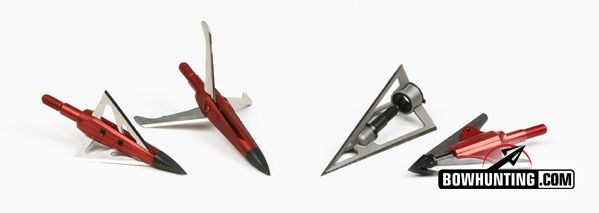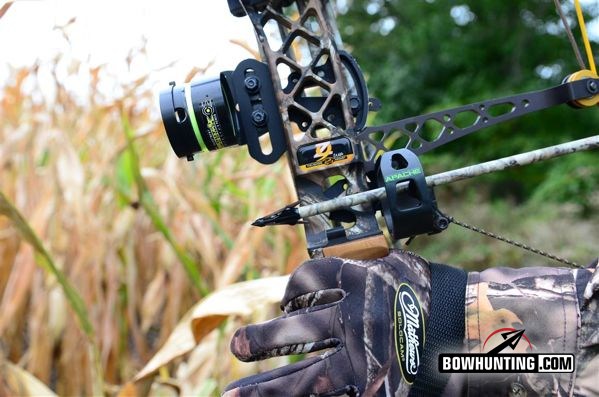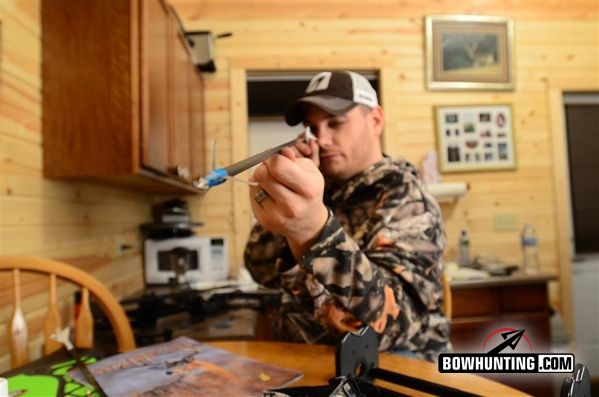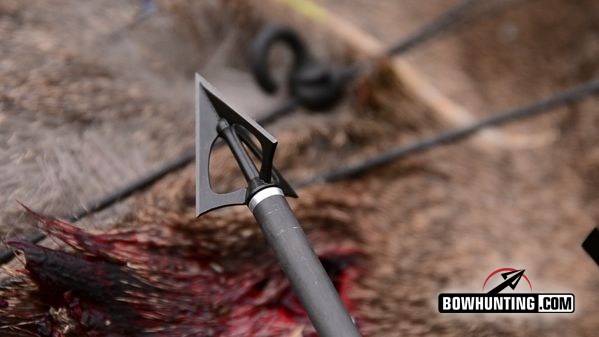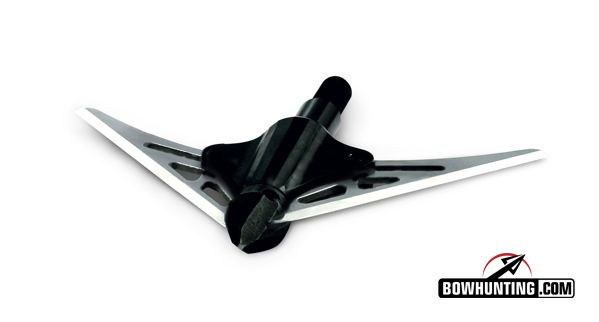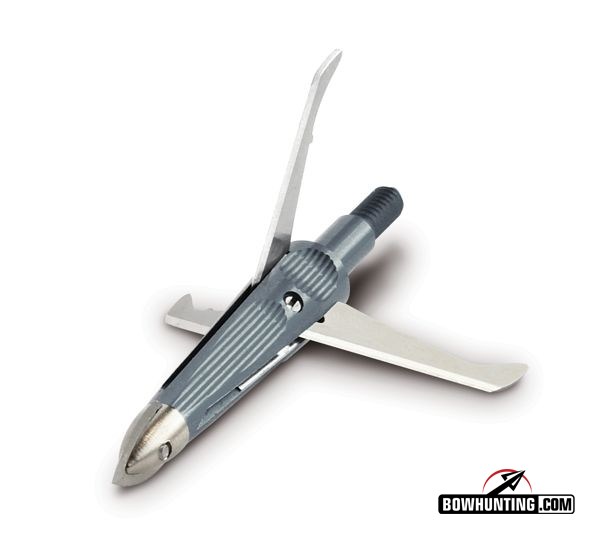LAST UPDATED: May 8th, 2015
One of the hottest topics in the archery world is mechanical broadheads, I don’t see this subject cooling down in the near future. I discussed mechanical broadheads (and fixed blade broadheads) with Chris Kozlik of New Archery Products, here is what he had to say…
New for 2012, the Deep 6 broadhead family has been engineered for small diameter arrows such as the Easton Injexion.
Q: The most common knock on mechanical broadheads seems to be that their blades open in flight, causing the arrow to fly off target which results in either a miss or a lost animal. What do you think about that?
A: Modern bows are certainly pushing the envelope on speed. Crossbows even more so. Having the blades on a mechanical head stay closed during flight is critical to hitting your mark. We’ve done extensive testing to make sure our heads work perfectly and stay closed during flight with the fastest equipment on the market. It’s easy to test. Hang a piece of paper in front of your target and shoot thru it. You should have a small hole, that shows the blades stayed closed. If not, it’s time to go find a better mechanical head.
Blades that open in flight are one of bowhunters major concerns in regards to mechanical broadheads.
Q: When it comes to shooting whitetail-sized game is there anything to be concerned about when shooting a mechanical broadhead?
A: Even though mechanicals have been on the market for over 20 years, there are still myths that revolve around the use of mechanical heads. Three statements seem to come up in conversation more than any others. Specifically, “You can’t take an angled shot with a mechanical” or “It takes too much energy to open the blades / a mechanical won’t penetrate well” or “My broadhead didn’t open!” I’d like to address these one at a time.
First off, any correct angled shot that you would take with a fixed blade, you can take with a mechanical. There are no additional restrictions. 45 degree quartering shots are no problem. Angles steeper than that and you risk the shot, mechanical or fixed blade, period. Three years ago, I received an email from a happy Spitfire customer who took such an angled shot that he cut 8 ribs clean thru and still had a full pass thru. I still have the pictures. Understanding that this shot should never have been attempted with a bow and arrow, it nonetheless proved to me the effectiveness of a full mechanical head even on a steep angled shot.
About blade opening and penetration, I’ll take that question in two parts.
Our mechanical heads use very little energy to open. The resistance that you feel by slowly opening a blade by hand simply isn’t there when the head slams into a target. I routinely demonstrate this by shooting a Spitfire thru a piece of cardboard using nothing more than a draw length check bow with a draw weight of 3 pounds. Blades will open every time. Now imagine a hunting arrow going 250 feet per second (which is 170 miles per hour!) with 60 pounds of kinetic energy. Even a modest 45 pounds of kinetic energy will cleanly kill any big buck out there with any well designed mechanical.
The biggest obstacle to getting a full pass is not the broadhead on the end of your arrow, but how well that arrow was flying as it hits the target. Any side to side whipping or porpoising of the arrow , either from a poorly tuned rest or string slap on your hunting clothes, will cause drastic reductions the penetration power of the arrow, regardless of the broadhead you choose. A bad flying arrow at close distance is even worse than one shot at longer distance because the vanes have no chance whatsoever to recover or get that arrow flying properly. In just the last few days I’ve had 2 bow setups, one being my own personal bow, which shot excellent field points at long distance (my first 50 yard robin hood) and still had a barrel rolling arrow coming out of the bow. Had I just installed a broadhead and gone hunting, the results would have been, regrettable. It’s easy to blame the broadhead when something goes wrong and in a lot of cases, the broadhead had nothing to do with the poor results. Take the time to tune your setup to perfection before stepping into the woods.
“My broadhead didn’t open,” is one of the biggest fear some people have of shooting a mechanical head. In the closed position, all of our heads are still angled partially open. In the 15 years that we have produced the Spitfire, we have never had a head that didn’t open. Like pushing on a door handle, the door has no choice but to pivot around its hinge and open. Now, what has tricked a few people along the way is that the blades may slam shut if the head goes thru a deer and into the dirt. Also in practice, if the head pops out the back of a target and the arrow stays in the target, the blades will again rocket forward and slam shut. In all cases, the head will show a little dent where the back of the blade whacks into the edge of the ferrule. It’s a witness mark that happens even on lower poundage bows. You can test this by taping a piece of paper on the back of a target block and shooting thru. Three large slots will be left in the paper. Even withdrawing an arrow from a deer or foam target will fold the blades closed again. On a yearly basis, I will receive one or two suspect heads where a customer believes it didn’t open. I’ll take a head that’s full of fur, dried blood, and dirt and shoot it as-is. The head will open perfectly! A few years ago, I shot a doe in Seneca, Wisconsin, quartering away at 20 yards with the first Spitfire Maxx prototype. The doe went downhill and out of sight. When I retrieved my arrow, the blades were shut. My gut response was predictable, I thought it didn’t open. Then I took a deep breath, looked for the dents where the blades hit the ferrule and found the head had worked perfectly. My doe was laying 50 yards away.
Q: Do mechanical broadheads really fly better than fixed-blade broadheads?
A: Yes. We have found that at or above 270 feet per second is where larger fixed blade heads can exhibit some wind drift. With precision tuning of the arrow rest and looking closely at the spine of the arrow, large fixed blades like the Thunderhead, can be made to fly extremely well. The faster the arrow goes, the more time you may need to spend on the tuning. Mechanicals almost always fly like field points. There’s very little wind resistance on mechanical heads, so no way to steer the arrow off of target. In 2001 I shot a caribou at 43 yards with a Spitfire with 30 mpg gusty winds and raining. Looking back at the video, you can see the arrow tracking perfectly to the animal and see just a white tuft of hair blow out the back of the animal. It was one of my best kills I’ve ever had, especially in bad conditions.
At high speeds fixed-blade broadheads can drift and plane but with a little bit of tuning, they too can fly like fieldpoints.
Q: Under what circumstances should someone not shoot a mechanical broadhead?
A: 40 foot pounds of kinetic energy would be the minimum I’d recommend when shooting a mechanical head. This would also be the minimum for fixed blades as well. Arrow flight and tuning is even more critical with bows that generate less kinetic energy. With today’s equipment, most hunters are far above this minimum.
Q: The hot trend in broadheads right now is massive cutting diameter. What do you think about that? And how does it affect arrow penetration?
A: Yes, cutting diameters on mechanicals are on the way up. With a setup that has 65 to 70 pounds of kinetic energy, the diameter can be increased with no lack of penetration on game animals. Our FOC crossbow head has a three inch cutting diameter. With crossbows generating 100 pounds of energy or more, this is no issue at all. That being said, it’s easy to forget that what was once an average cutting diameter of 1-1/4” a few years ago, some people now consider small. For decades Thunderheads have killed more deer, elk, moose and other big game animals with a cutting diameter of 1-3/16”. Moose and elk hunters have loved the killing power of the 1-1/8” Nitron for years. Blade sharpness, broadhead strength and quality, along with shot placement and arrow flight seem to be much more important than initial cutting diameter. We’ve seen many Spitfire kills where the entrance hole is bigger that the cutting diameter of the head!
Giant cutting diameters are the hot trend, like this Spitfire Maxx.
Q: We all know that the sharpness of the blades on your broadhead is important for a quick kill, better blood trail and short recovery. How can the average bow hunter decide which broadheads have the sharpest blades?
A:Determining broadhead sharpness can be a little tricky sometimes. A lot of people will run their fingers over the blade and if you can feel it catch your skin, they believe it’s sharp. What you’re actually feeling is a roll over burr that some blades produce when being sharpened. Once the burr breaks off, there is a microscopic rounded edge that does not cut cleanly. It’s when you feel nothing at all, then look down and see your blood all over the place, then you truly have a sharp edge. If you don’t want to find out the hard way, slice thru a piece of notebook paper or shave the hair off the back of your hand to be sure. We make sure nothing touches the edge of our blades between when they were manufactured and when you screw them on you arrow to guarantee the sharpest blades possible.
There is no substitute for ultra-sharp blades, the blades on the NAP Hellrazor are just that.
Q: Why should bow hunters replace the blades on their broadheads with new ones from the manufacturer rather than trying to sharpen them on their own?
A: It’s always better to have brand new blades on your heads. Most blades like ours have multiple grind angles that can never truly be resharpened effectively by hand. A solid head like a Hellrazor can be made almost as sharp from the factory by using a high quality flat stone. Patience and skill are needed to get the edge perfect. I cannot overstate the importance of sharp blades for killing game animals as quick as possible. The cost of new, sharp replacement blades may be the difference between finding an animal or not when a marginal hit occurs.
Q: Is there any advantage to shooting a 125 grain broadhead rather than a 100 grain broadhead?
A: We’ve found that heavier heads up front do two important things. For one, they just seem to fly better. Moving the front of center balance point forward helps the arrows (or bolt) fly better. Tenpoint Crossbows regularly put brass inserts in their bolts for that very reason. In addition, the penetration power in increased. Studies have been done showing that an arrow of a given weight will out penetrate by just moving the weight forward. I put this to the test last year with a fellow employee at New Archery who has never had a full pass thru. He shoots a lighter weight bow and a short arrow. I constructed some Easton Full Metal Jacket arrows with a 60 grain brass insert. 24-1/2” arrow, 100 grain broadhead for a total weight of 428. Front of center comes in at 15.3 percent. Full pass thru’s are now happening. Don’t worry about any extra drop. Even 25 grains extra up front in stays inside a hunter’s normal grouping pattern inside of 30 yards. Arrow speed loss is negligible and in most cases, the kinetic energy has increased! Whatever grain weight broadhead you choose, make sure your arrow is spined out correctly.
Q:The past two years we’ve heard a lot about the NAP Bloodrunner broadhead. Can you tell us why this head has been so popular with bow hunters?
A: Mechanical head sales have soared over the last few years. There are dozens of different designs to choose from. Unfortunately some just don’t perform as well as others under hunting conditions. The Bloodrunner broadhead appeals to hunters who may have tried mechanicals before with bad results or people who would like to try a mechanical, but just seem leery about the whole idea. The Hybrid design of the head is such that in closed position, it has a 1 inch cutting diameter, and by pressing the point back, expands to 1-1/2”. “Even closed, it’s bound to work” is what I hear from potential customers. The fact is there’s no way for it not to open to 1-1/2” cut when passing thru a target. Confidence is key when selecting a broadhead and it’s easy to see how this head performs.
The NAP 2-Blade Bloodrunner offers a huge cutting diameter and a fail-proof expanding design.
Q: What broadhead will you be shooting this fall?
A: That’s always the toughest question for me to answer because all of the heads we make work so well. A lot of us over here shoot Spitfire’s and Bloodrunner’s. I’ll be shooting the Spitfire Maxx with a 1-3/4” cut. I just need to stay awake in the tree long enough to let one fly…..
The Spitfire Maxx is one of the favorite mechanical broadheads on the market.

 By
By 